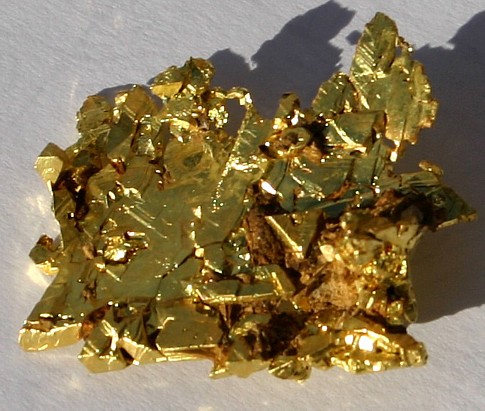While it's hard to imagine things like gold or quartz being dissolved away by water solutions, things are different if the water is hot enough, the pressure high enough, and the chemistry is right (including acids, and other elements like sulfur). Under those powerful conditions then gold, quartz and other things you don't expect to see dissolving will go into solution. The solutions move by natural convection (hot things rise), and as they rise the waters cool as they move farther from the heat source in the ground and closer to the surface. The gold is combined with sulfur to form gold-sulfur chemicals that dissolve in the water. I have specifically decided to avoid going into the complex geochemistry of gold solutions in this whole discussion, because I just don't think it's necessary to do that for people who are out prospecting with a metal detector.
At times the circulating mineral waters can go though wide zones where a whole area of rock is porous, and if there is enough solution moving and depositing gold, you might get a big disseminated deposit, like those mined by open pit here in Nevada. Normally however, that results in a very fine sized gold. The most common geochemistry required to dissolve gold involves sulfur, which is why sulfides like pyrite, galena and arsenopyrite are so commonly associated with gold bearing veins. In most gold deposits, the gold does not form into well-developed crystals. Unlike quartz which often forms good crystals, gold requires a very specific set of circumstances to grow into good crystal shapes, and those conditions are not that common. Few gold deposits produce good crystal specimens, as most gold forms naturally into irregular masses and lumps. Many of the irregular masses have a form suggesting that they might have been melted at one time, but that is virtually never the case. However, where the right conditions are present, gold can form in a variety of crystal shapes, including dendrites, leaf, deformed octahedrons and cubes. The placer field at Rye Patch (Majuba) in Nevada is one of the places where the conditions were right for the growth of crystallized gold. This location has gained a reputation for some nice looking specimens - the term "chevron" is used to describe the typical shape. Not all Rye Patch gold has the chevron shape, but the chevron shaped nuggets are fairly common there. The chevrons I think are a combination of the dendrite and the octahedron forms. Some unusual set of chemistry, temperature and pressure conditions present at Rye Patch led the gold to grow into these attractive V shaped crystals. Even lump-like nuggets, when they are cut open and the cut surfaces properly etched, will show that on the inside they are crystalline.
Because the prospector using a metal detector is primarily interested in coarser gold as larger nuggets are easier to detect, and of course, more valuable! It turns out that coarse gold most commonly forms in small veins (and for the sake of argument here, lets say for our discussion that coarse gold is stuff a Penney weight or larger). Big veins, with a width and length large enough to be mined commercially underground, almost always produce small gold - little wires, small pieces, tiny specks, etc - even though they may be fairly rich overall. Of course, there are a number of exceptions to this rule, but generally speaking, it is true. So why, in general, does big gold form in small veins, while mostly only small gold forms in big, wide veins?
Often, the source of the heat driving the gold forming system is some sort of cooling magma (lava, still molten or solidified but still hot). This kind of heat source throws off so much heat energy that the rock may well be warm to within 100 feet of the surface, even if the source is over 2000 feet down. The temperature does not drop off suddenly once the solution gets a short distance from the source. The drop in temperature as you move away from the heat source is gradual, and usually fairly linear, at least within a few hundred feet of the surface. So the temperature of the rock (and the water solutions as well) becomes directly related to how far they are from the heat source. The rate of cooling then becomes a simple function of how fast the fluids move upward.
With that in mind, small feeder veins, and splits off the main vein are in some ways the quiet backwaters for the solutions forming veins. Smaller openings just don't allow as much flow volume, and the slower flowing solution can take its time to cool and release its mineral load. The small flows of the small veins move upward slowly and have a chance to take their time to cool. This results in fairly stable conditions in the growth zone where decreases in temperature and pressure are such that minerals, including gold, can grow to a good size. These smaller veins are still spotty in their values, with some parts rich in coarse gold, and other parts low in grade and nearly barren. Usually these veins are far too small for any commercial underground mining operations, with widths of up to a few inches and strike lengths of 5 to perhaps 50 feet. In addition spotty values make them noncommercial as well.
Continue on to:
Coarse Gold: Part I, Nugget Growth
Coarse Gold: Part II, Geologic Examples
Return To:
All About Placer Gold
Deposits


